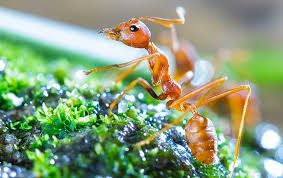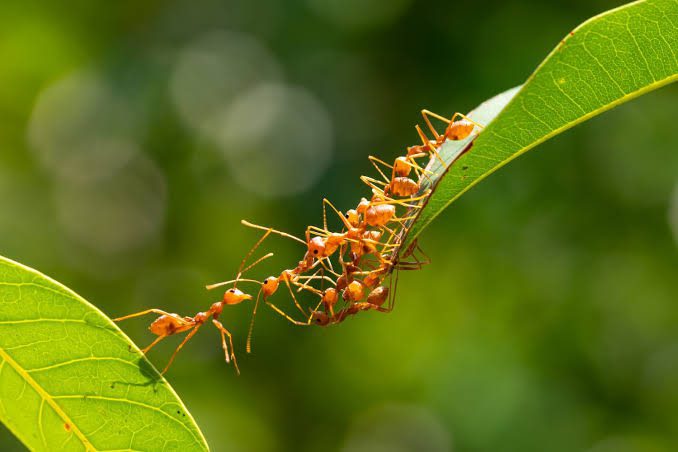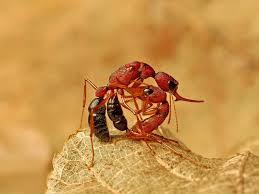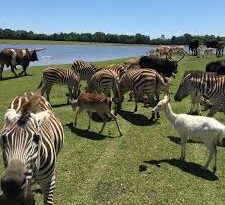Ants: Description, Damages Caused, Control and Preventive Measures
Ants are fascinating creatures that belong to the family Formicidae. These tiny insects play a crucial role in ecosystems by not only being highly organized social insects but also by engaging in activities that contribute to the balance of nature.
In many ways, ants act as nature’s pest controllers. Some ant species have developed unique relationships with other insects, especially aphids. Aphids are known for damaging plants by feeding on their sap. However, certain ants have formed a symbiotic alliance with aphids, creating a beneficial partnership for both parties.
Ants protect and farm aphids by providing them with shelter and protection from predators. In return, the aphids secrete a sugary substance known as honeydew, which ants collect and consume. This exchange of services is a remarkable example of mutualism in the natural world.
The ant-aphid relationship begins when ants discover aphid colonies on plants. Once located, ants will fiercely defend these aphids from potential threats such as ladybugs and other predators. Ants use their strong jaws and aggressiveness to ward off any danger, ensuring the safety of their aphid partners.
Ants also demonstrate farming behaviors, as they actively tend to aphid colonies, moving them to new plant locations when needed. This behavior helps ants ensure a steady supply of honeydew from the aphids. The mutualistic bond formed between ants and aphids showcases the intricate web of relationships that exist within ecosystems.
Beyond their role in pest management, ants contribute to soil health. Ants burrow into the ground, creating channels that enhance soil aeration and drainage. These activities also aid in the decomposition of organic matter, playing a part in nutrient cycling.
The social structure of ant colonies is another captivating aspect. Ant colonies consist of worker ants, soldiers, and a queen. Each member has specific roles, contributing to the overall success of the colony. The queen is responsible for laying eggs, while worker ants engage in foraging, nursing, and defending the colony.
Their ability to form symbiotic relationships, such as with aphids, highlights their importance in maintaining ecological balance. As nature’s pest controllers and soil engineers, ants play a vital role in ensuring the health and sustainability of the environment.
Read Also: 16 Medicinal Health Benefits Of Cordyline fruticosa (Ti plant)
Plants Affected by Ants (Formicidae)

Ants, often recognized for their positive contributions to ecosystems, can also have notable effects on various plants. While some of these interactions are mutually beneficial, others can be detrimental to the plants involved.
One significant impact of ants on plants is their involvement in seed dispersal. Certain plant species have evolved to attract ants by offering nutritious appendages called elaiosomes attached to their seeds. Ants carry these seeds back to their nests, consume the elaiosomes, and discard the remaining seed in a different location. This process aids in seed dispersal and promotes the establishment of new plant growth.
However, ants can also be detrimental to plants in some cases. Some ant species are known to engage in aggressive behavior toward larger plants, particularly when constructing their nests. They may remove vegetation or disturb the soil, affecting the stability and health of plants in the area.
Another negative impact arises when ants protect and nurture specific insects that harm plants. For instance, certain ant species “farm” scale insects or mealybugs, which feed on plant sap. Ants protect these pests from natural predators, creating an undesirable situation for the affected plants.
Furthermore, ants may be involved in the spread of plant diseases. As they move among plants, ants can inadvertently carry pathogens, facilitating the transmission of diseases from one plant to another. This unintended role in disease dissemination highlights the complexity of the relationships between ants and plants.
While ants contribute positively to ecosystems through activities like seed dispersal, their interactions with plants can have both beneficial and detrimental aspects. Understanding the varied relationships between ants and plants is crucial for comprehending the intricate dynamics within ecological systems.
Damages Caused by Ants

Ants, despite their small size, can cause several types of damage, impacting both natural environments and human-inhabited spaces.
One notable source of damage is related to the foraging behavior of ants. Some ant species are attracted to food sources in homes, stores, or agricultural settings. They can contaminate food by carrying bacteria and other pathogens picked up from various locations. Additionally, ants can become a nuisance when they invade kitchens and pantries in search of crumbs and spills.
Certain ant species are known for their destructive impact on wooden structures. Carpenter ants, for example, excavate galleries within wood to build their nests. Over time, this activity can weaken the structural integrity of wooden buildings and furniture, leading to potential damage and costly repairs.
In agriculture, ants can pose a threat to crops. They may interfere with the germination of seeds, damage young plants, or tend to and protect harmful pests like aphids. The protection of pests by ants can lead to increased infestations and reduced crop yields.
Ants can also disturb the balance of ecosystems. In some cases, they outcompete native species for resources, affecting the diversity and abundance of other insects and small animals. Their aggressive foraging behavior and ability to adapt to different environments contribute to their success but can have negative consequences for local biodiversity.
In gardens, ants may disrupt the growth of plants by disturbing soil, especially in sandy or loose soils. Their nesting activities can create mounds that interfere with plant roots and disturb the overall garden landscape.
While ants play important roles in ecosystems, their activities can result in various damages. From contaminating food sources to causing structural damage and disrupting agricultural practices, understanding and managing ant-related issues is essential to mitigate their negative impacts.
Read Also: 16 Medicinal Health Benefits Of Syzygium suborbiculare (Bush Cherry)
Control and Preventive Measures

Controlling and preventing ant-related issues involves a combination of strategies to manage their presence in different environments. Here are some effective measures:
1. Sealing Entry Points: Identify and seal any cracks, gaps, or openings in buildings to prevent ants from entering homes or structures. Ensure that windows and doors are tightly sealed, as these are common entry points for ants.
2. Proper Food Storage: Store food in airtight containers to prevent attracting ants to kitchens and pantries. Clean up spills promptly and regularly wipe down surfaces to remove food residues.
3. Maintain Clean Surroundings: Keep indoor and outdoor spaces clean, minimizing potential food sources for ants. Dispose of garbage regularly and ensure that waste bins have tight-fitting lids.
4. Trim Vegetation: Trim tree branches and shrubs that may come in contact with structures, as ants often use these as bridges to access buildings.
5. Eliminate Standing Water: Address any water leaks promptly, as ants are attracted to moisture. Remove standing water around the property to reduce potential nesting sites.
6. Natural Repellents: Use natural repellents like cinnamon, peppermint, or vinegar in areas prone to ant activity, as these scents can deter them.
7. Baiting: Employ ant baits containing insecticides that are carried back to the nest, effectively controlling the entire colony.
Place baits strategically near ant trails or entry points.
8. Professional Pest Control: In severe infestations, consider seeking the services of a professional pest control provider.
Professionals can assess the situation, identify ant species, and implement targeted treatment plans.
9. Regular Inspections: Conduct regular inspections of both indoor and outdoor areas to detect and address ant-related issues early on. Monitor for signs of ant activity and take proactive measures to prevent infestations.
10. Ant-Resistant Landscaping: Choose plants that are less attractive to aphids and other pests that ants may farm. Consider incorporating ant-repelling plants or barriers in landscaping.
Implementing a combination of these measures can help control and prevent ant-related problems, whether in homes, gardens, or agricultural settings. Tailoring strategies to the specific ant species and environmental conditions is key to effective management.
Frequently Asked Questions (FAQs) About Ants (Formicidae)
1. Q: Are all ants harmful?
A: No, not all ants are harmful. Many ants play essential roles in ecosystems, such as seed dispersal and pest control. However, some species can cause damage to structures or crops.
2. Q: How can I get rid of ants in my home?
A: To get rid of ants in your home, focus on sealing entry points, keeping areas clean, using ant baits, and addressing moisture issues. If the infestation persists, consider professional pest control.
3. Q: Why do ants invade kitchens?
A: Ants are attracted to kitchens due to the presence of food crumbs and spills. Keeping kitchens clean, storing food in sealed containers, and promptly cleaning up spills can deter ants.
4. Q: Do ants cause damage to wood structures?
A: Yes, some ant species, such as carpenter ants, can cause damage to wood structures by excavating galleries for nesting. Regular inspection and prompt treatment are crucial to prevent significant damage.
5. Q: Can ants harm plants in gardens?
A: Yes, ants can harm plants in gardens by disrupting soil, tending to harmful pests like aphids, and creating nests that may interfere with plant roots. Implementing good garden practices and pest control measures can help mitigate these issues.
6. Q: What are natural ways to repel ants?
A: Natural repellents for ants include substances like cinnamon, peppermint, vinegar, and citrus peels. Placing these near ant entry points or trails can help deter them.
7. Q: How do ant baits work?
A: Ant baits contain insecticides disguised as attractive food. Worker ants carry the bait back to the nest, where it is shared with the colony, effectively controlling the entire population.
8. Q: Can ants transmit diseases?
A: While ants themselves are not known to transmit diseases directly to humans, their foraging activities may contaminate food surfaces. It’s essential to keep food areas clean to minimize potential health risks.
9. Q: What should I do if I find ant nests in my yard?
A: If you find ant nests in your yard, consider using ant baits, eliminating attractive food sources, and addressing moisture issues. For severe infestations, professional pest control may be necessary.
10. Q: Are there ant-resistant plants for gardens?
A: Some plants, like marigolds and mint, are known to repel ants. Planting these in and around your garden may help discourage ant activity. Additionally, maintaining a healthy garden environment can reduce susceptibility to ant-related issues.
Read Also: The Impact of Waste to Art Business









